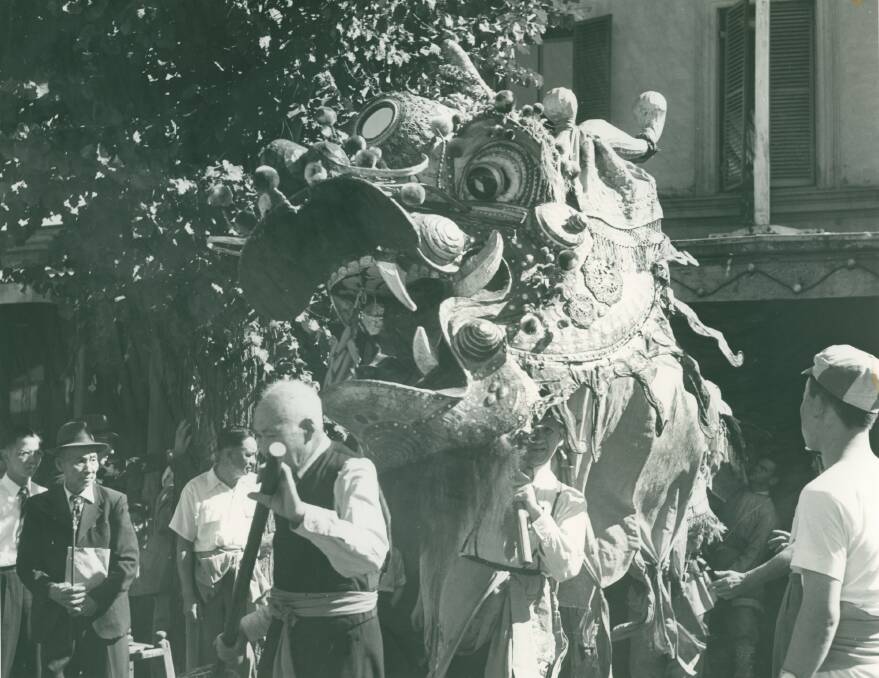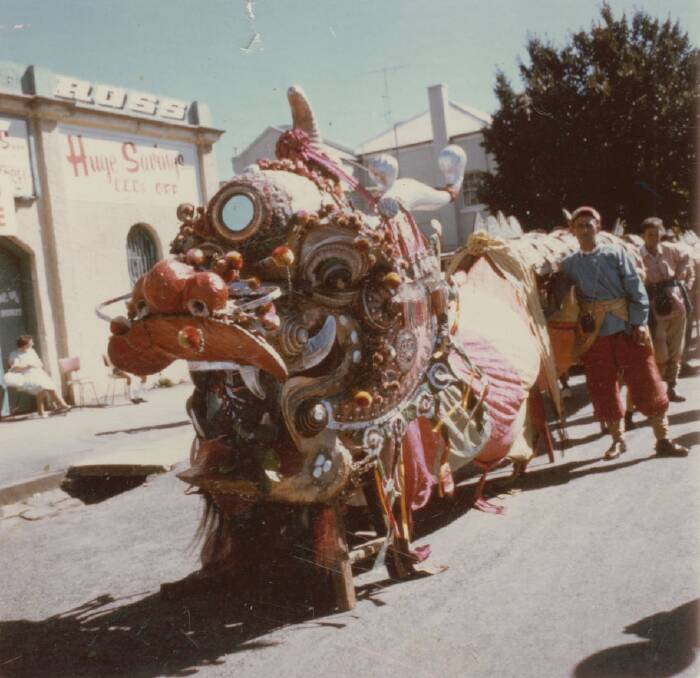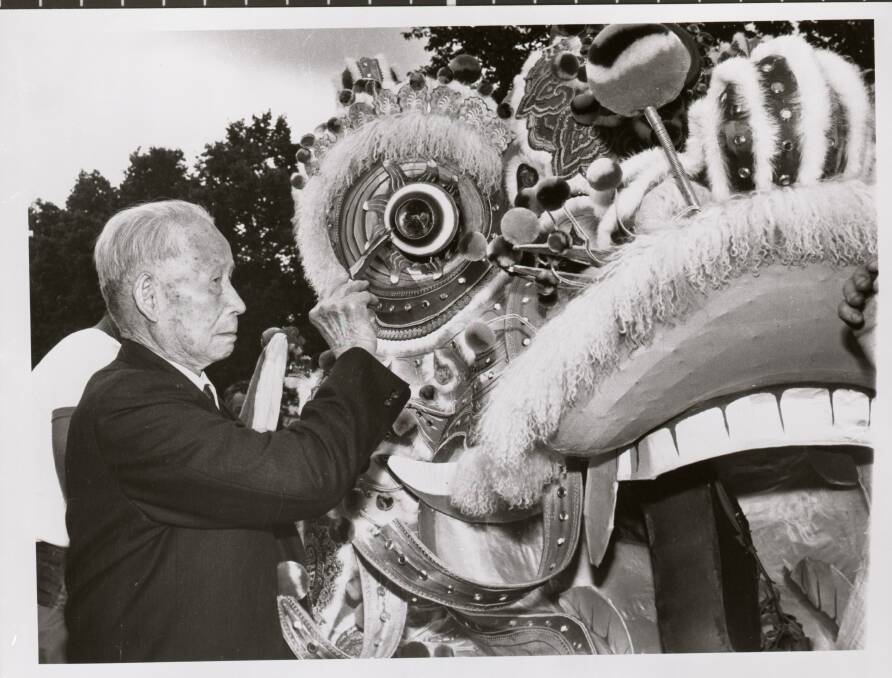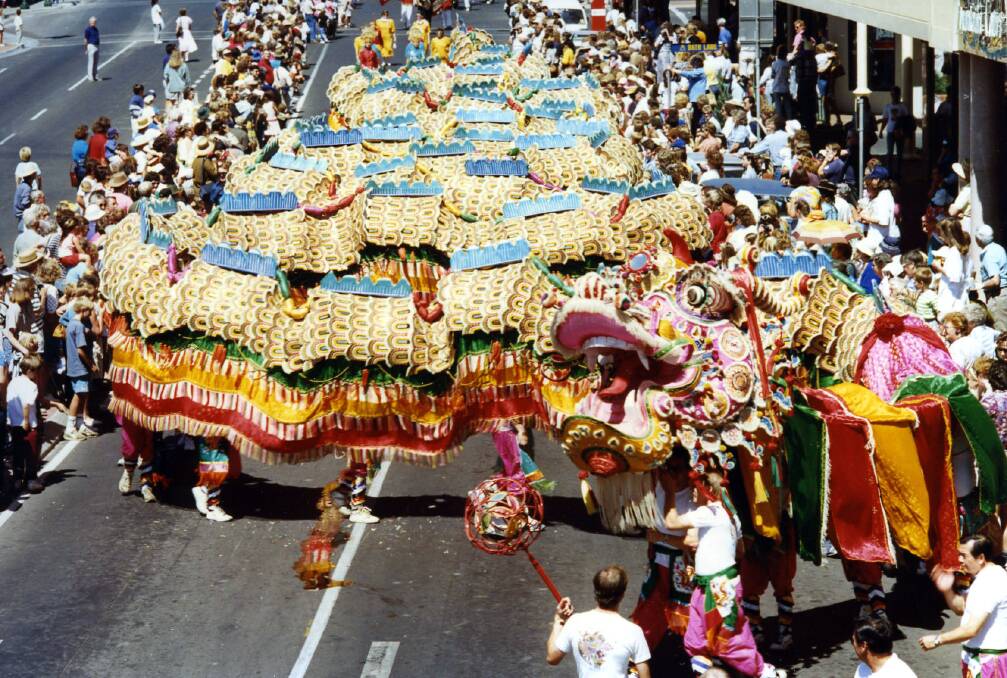The oldest surviving imperial dragon in the world, Loong, started his life in a workshop in the Chinese city of Foshan in the late 1800s.
Subscribe now for unlimited access.
or signup to continue reading
"Loong still has his maker's mark on the back of his head," Golden Dragon Museum research officer Leigh McKinnon said.
"Unfortunately we don't know much else about the Sing Cheng workshop where he was made, but we do know that the workshop also made dragons for parades in Los Angeles and Ballarat."
The workshop was a couple of hundred kilometres outside of Hong Kong, so Mr McKinnon said the journey to Australia was uncomplicated.
"There were regular ships coming between Hong Kong and Australia so it would have been relatively easy to ship Loong across," he said.
"He would have been all packed up in boxes and sent to Melbourne, where he then would have been put on a train to Bendigo."
There is some dispute around when Loong was brought to Bendigo. Chinese Dragons featured in the city's parades since the 1890s and there are photos of the dragons from as early as 1892.
Many believe that was when Loong made his first appearance but Mr McKinnon said Loong was not one of the first dragons.

Instead, the first recorded photo of Loong shows him at the 1901 celebration of federation in Melbourne.
"There was a parade for the visit of the Duke and Duchess of York who officially opened the first parliament," Mr McKinnon said.
"There are photos of Loong out the front of Parliament House on Spring Street in Melbourne."
Loong's grandeur was on show in Bendigo during every Easter parade between 1901 and 1970.
He was also a travelling dragon for a few decades. He performed for charity events in places like Melbourne, Adelaide and Echuca.
Despite being over a century old, Loong still remains intact. His longevity is testament to his craftsmanship.
The thousands of scales that line his head and body were handmade from layers of mirrors, material, papier-mache, and kingfisher feathers. His head was also made out of a traditional bamboo frame.
"Each dragon is very complex and very fragile," Mr McKinnon said. "In China, they would be regularly replaced after a few years.
"But here in Bendigo because of the isolation of the community and the fact that the Chinese community became less wealthy after the Gold Rush, they had to hold onto Loong for much longer."
Loong's decades of parades in Bendigo were not without some drama.
"Loong at one stage lost his horns during a parade in the 1960s," Mr McKinnon said. "It was one ill-judged turn near a lamp post and the horns were knocked off.

"There was also a time where one of the dragon head carriers ended up with some firecrackers down his shirt. He ended up in a panic and the parade was definitely disrupted, but I want to emphasise that it goes to plan more often than not."
As the 1960s drew to a close, it was decided a new dragon was needed to take the place of the ageing Loong.
"He was too old to keep going," Mr McKinnon said. "The dragons are very fragile so they need a lot of care, which the association evidently did because Loong paraded much longer than he probably should have."
In 1969, the Bendigo Chinese Association, local businessmen and politicians - a group which called themselves the Loong 100 - gathered together to raise donations for the new dragon.
"Sun Loong came about because it wasn't just the Chinese community but also the Bendigo community as a whole which had great affection for the dragon parade," Mr McKinnon said.
The funds were raised and the search for a traditional dragon maker began. The Loong 100 started looking in China.
"At that point, China was going through the Cultural Revolution," Mr McKinnon said. "China was in turmoil so there was no way the dragon could be made on the mainland."
The group shifted their search to neighbouring Hong Kong, which at that time was still a British colony. Traditional dragon maker Lo On was found and chosen to create Bendigo's new dragon Sun Loong, or new dragon.

"It was a shift from Loong and the other older dragons who were made in mainland China," Mr McKinnon said. "But Hong Kong was the best place. Sun Loong is not a copy of Loong but has many of the same features. He is more of the old fashioned style and has the mirrored scales just like Loong."
In 1970, Loong bowed out from the Easter parade and passed on the baton to the new dragon, Sun Loong.
"Back then the parade was still on the Easter Monday," Mr McKinnon said. "So on Easter Sunday we had Loong's last parade. He then came out again on the Monday where he handed over to Sun Loong."
Sun Loong has held the title of the longest dragon of its kind in the world. But Mr McKinnon said there was a time when that was challenged.
"Sun Loong was originally 200 feet long or around 66 metres," he said. "In 1979, the Melbourne Chinese community made their own dragon Dai Loong and made sure it was longer than Sun Loong.
"Even before Dai Loong reached Melbourne, the Bendigo Chinese Association got into talks with local businessmen to raise more money so they could pay Mr Lo On to make a 100-foot extension.
"The extension was sent to Bendigo before the end of the year and they attached it to Sun Loong. He was returned as the longest working dragon at 300 feet or 100 metres long."
Sun Loong has spent the past five decades parading through the streets of Bendigo every year, but there was one year where he missed the Easter parade.
"In 1983, Sun Loong paraded for Prince Charles and Princess Diana during their visit to Bendigo," Mr McKinnon said. "That was before Easter but when Easter came, it bucketed down rain so he couldn't come out for the festival."

Ten years ago, the Bendigo Chinese Association and the Golden Dragon Museum decided it was time to start looking for its next dragon.
But the groups were apprehensive about whether there was a master who could make a dragon of the same quality and style as Loong and Sun Loong.
"There were several years of research," Mr McKinnon said. "We went on a fact-finding mission to Hong Kong in 2016 and did a lot of research on the internet and on social media. It's a bit of a different world now to how they were trying to find a dragon maker in 1969."
In May last year, Master Hui was selected as the dragon maker for Dai Gum Loong, or big golden dragon.
"They were officially awarded the contract not just because they were the best skilled for the job, but because they had the backing and capability to make the dragon in the required time frame," Mr McKinnon said.
Dai Gum Loong was constructed between June and February this year. He was blessed at the Fuk Tak Temple in Hong Kong in February, before arriving in Bendigo a couple of weeks ago.
"Dai Gum Loong is very traditional in his scales which is something that was required when we were looking for a dragon maker," Mr McKinnon said.
"He has the mirrored scales and the layers of material of the same quality as Loong and Sun Loong.
"His head, in some ways, has elements of the style of earlier dragons but he is also very much his own dragon in terms of his colour.
"It's a homage to tradition but Dai Gum Loong is still very much a modern dragon. The two elements are blended together."
Dai Gum Loong has now taken over the title of the longest dragon of its kind in the world at 120 metres long.
"We believe there may be a dragon in Macau that is longer but it's scales are printed on," Mr McKinnon said. "It's easier to make a dragon like that."
This year, the three generations of Chinese dragons will parade through the streets of Bendigo for the Bendigo Advertiser Gala Parade. The night dragon Yar Loong will also be joining the Easter festivities for the first time since 2012.
"It is very exciting for Bendigo and it's exciting for us as well," Mr McKinnon said. "We know these dragons and we've seen them over the years. It's kind of a handing over."
Have you signed up to the Bendigo Advertiser's daily newsletter and breaking news emails? You can register below and make sure you are up to date with everything that's happening in central Victoria.


